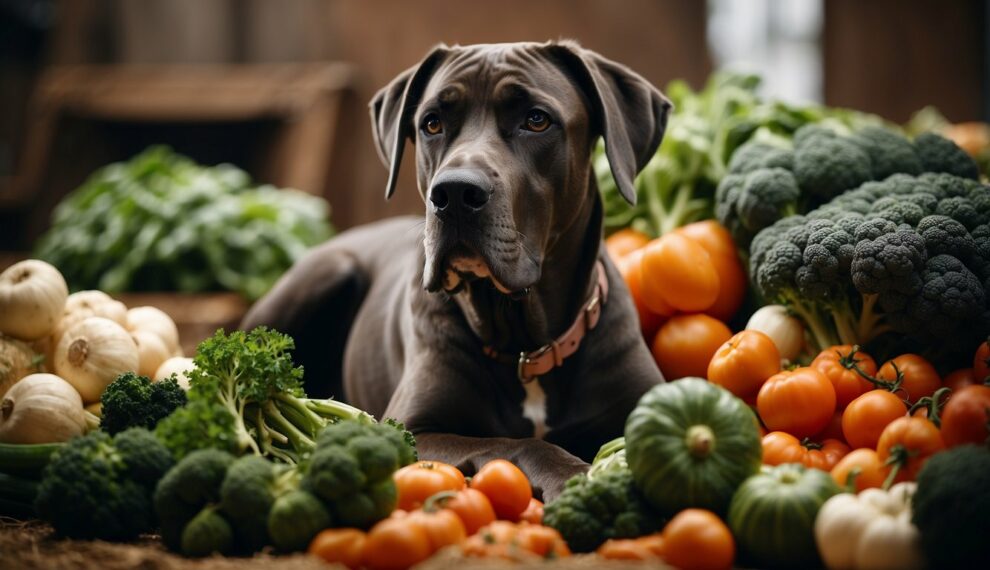As a pet owner, I know how important it is to maintain a balanced diet for our four-legged friends, which includes the right amount of fiber.
Fiber is a crucial component of a dog’s diet, much like it is for humans.
It offers a multitude of health benefits, including aiding digestion and helping to manage weight by keeping our dogs feeling full for longer.
I’ve noticed in my own experience how a fiber-rich diet can contribute to my dog’s overall well-being, keeping them active and happy.

Not all sources of fiber are created equal when it comes to canine nutrition.
Dogs need both soluble and insoluble fiber, each serving a different purpose.
Soluble fiber dissolves in water and helps to regulate blood sugar levels and reduce cholesterol, while insoluble fiber adds bulk to the stool and helps food pass more quickly through the stomach and intestines.
In searching for the best sources of fiber for dogs, it’s essential to look for options that provide this balance while also being safe and appealing for our pets to eat.
Understanding Fiber in a Dog’s Diet

In my experience with canine nutrition, I’ve learned that fiber plays a vital role in maintaining a dog’s health.
It’s not just filler; it’s essential for proper digestion and can help prevent various diseases.
Types of Fiber
There are two main types of fiber that are important in a dog’s diet: soluble fiber and insoluble fiber.
Soluble fiber dissolves in water and can help to regulate blood sugar levels by slowing down digestion.
It can be found in foods like apples, carrots, and oats.
On the other hand, insoluble fiber does not dissolve in water and helps to move food through the digestive system, which is beneficial for preventing constipation.
Good sources of insoluble fiber for dogs include vegetables like green beans and broccoli.
Benefits for Digestion
Fiber is a champion for a dog’s digestive system.
For starters, it helps create a sense of fullness, which can prevent obesity by keeping your dog from overeating.
Soluble fiber can help with diarrhea by absorbing water and adding bulk to stools.
Insoluble fiber, meanwhile, prevents constipation by adding bulk to the stool and aiding in regular bowel movements.
Role in Disease Prevention
By keeping a dog’s digestive system running smoothly, fiber can play a role in disease prevention.
A high-fiber diet has been associated with a lower risk of colon cancer.
Fiber helps in managing diabetes in dogs by moderating how fast sugars are absorbed into the bloodstream.
Maintaining a healthy weight with a fiber-rich diet can also lower a dog’s risk of obesity, which is a precursor to many health issues.
Throughout the years, I’ve been careful to ensure my dog has a diet rich in both types of fiber for a happy, healthy life.
High-Fiber Foods for Dogs

Fruits and Vegetables
When I think of fruits and vegetables that are beneficial for dogs, pumpkin immediately comes to mind.
It’s not only rich in fiber but also low in calories, making it a fantastic choice for my dog’s digestive system.
Green beans are another fiber-rich option, and my dog enjoys them as a crunchy snack.
Other fruits and veggies like apples, sans seeds, and carrots also make the list for their fiber content and palatability.
- Pumpkin: Great for digestive health, ensure it’s pure with no added sugars or spices.
- Green Beans: A low-calorie snack that’s also full of fiber.
- Apples: Slice them up for a sweet treat, keeping the core and seeds away.
- Carrots: Crunchy and good for the teeth, they offer fiber and beta-carotene.
For berries, I find blueberries and strawberries to be the perfect size for a small, fiber-rich treat, and they’re packed with antioxidants.
- Blueberries: A superfood that’s as good for dogs as it is for humans.
- Strawberries: Juicy and full of fiber, but I give them in moderation due to their sugar content.
Additionally, sweet potatoes and peas are great sources of dietary fiber and other nutrients.
Broccoli is also fiber-rich, but I make sure to serve it in very small quantities due to its potential to cause gas.
- Sweet Potatoes: A sweet source of fiber, vitamins, and minerals.
- Peas: Packed with fiber and protein.
- Broccoli: I serve it sparingly to prevent digestive issues.
Grains and Legumes
Moving on to grains, brown rice is a go-to for dietary fiber in my dog’s meals.
It’s a whole grain, so it retains the fibrous bran layer that white rice lacks.
Seeds, like flaxseeds or chia seeds, are another excellent fiber addition to my dog’s diet; they’re also rich in omega-3 fatty acids.
- Brown Rice: A nutritious whole grain, much better than white rice in terms of fiber.
- Seeds: I sprinkle some flaxseeds or chia seeds on top of my dog’s food for extra fiber and omegas.
Each of these foods can contribute to your dog’s fiber intake, but it’s important to introduce them slowly and observe for any adverse reactions, like allergies or gastrointestinal upset.
Remember, every dog is different and it’s best to consult with a vet before making significant changes to their diet.
Commercial High-Fiber Dog Foods
When I’m looking for the best high-fiber dog foods, I pay close attention to nutritional value and ingredients to make sure my dog is getting the benefits fiber offers.
Fiber aids digestion and can help manage weight, so it’s a crucial component of a dog’s diet.
Understanding Labels
Ingredients: The first thing I do is skim through the list of ingredients on dog food labels.
Dietary fiber sources should come from high-quality plant-based ingredients.
What I want to see are items like peas, beans, and beet pulp – these are fantastic sources of fiber and suggest a higher overall nutritional value.
AAFCO Standards: Another important aspect is ensuring the food meets the Association of American Feed Control Officials (AAFCO) guidelines.
This organization sets nutritional standards that help me understand if the dog food provides complete and balanced nutrition.
Choosing Quality Food
Analysis Breakdown: I check the guaranteed analysis to see the specific levels of protein, fat, carbohydrates, and fiber.
High-fiber dog foods should not just replace quality protein or fat with more fiber; balance is key.
Veterinarian Recommendation: Before making any diet changes, always consult with your veterinarian.
They can provide insights into how much fiber my dog needs based on their age, weight, and health condition.
Plus, veterinarians often know which commercial dog foods offer the best nutritional value while still being low in calories and fat but rich in other nutrients.
By keeping these points in mind, I can navigate the sometimes confusing world of commercial dog food and find a high-fiber option that’s right for my dog.
Incorporating Fiber into Your Dog’s Diet

Supplements and Additives
When it comes to adding fiber, supplements are sometimes a convenient option.
Two excellent choices include psyllium and beet pulp; they are well-tolerated by most dogs and can be mixed into their regular meals.
I also like to use canned pumpkin or pureed pumpkin as they are natural and rich in fiber.
It’s simple: I just add a dollop to my dog’s food.
However, for weight management, I consider fiber-rich supplements that might have added probiotics, which aid in digestion and intestinal health.
Working with a Veterinarian
Before you make any significant dietary changes for your dog, consult with my vet.
This is crucial for a personalized dietary plan, especially if your dog has specific health concerns like weight loss needs or digestive issues.
Your vet can advise you on the right amount and types of fiber-rich additives or supplements that should be added to your dog’s diet, ensuring they are both safe and effective.
Health Considerations and Monitoring
Signs of Excessive Fiber
Digestive problems like constipation or diarrhea: If you notice these symptoms, it might indicate your furry friend is getting too much fiber.
Vomiting or straining could be signs that their body isn’t coping well with the high fiber content.
Anal gland issues: An excess of fiber can lead to bulky stools, which may not press on the anal glands during defecation, leading to anal gland blockages.
Weight management concerns: High fiber diets are often used to help manage a dog’s weight.
However, too much fiber can cause nutritional imbalances, making weight control even more challenging, especially in senior dogs who might not be as active.
Adjusting the Diet Over Time
When introducing new foods, adjust your dog’s diet gradually to prevent digestive upset.
If you’re trying to address specific health issues like colon health or weight management, make careful adjustments while observing your dog’s reaction over time.
Remember to tailor their fiber intake based on their age, weight, and activity level.















